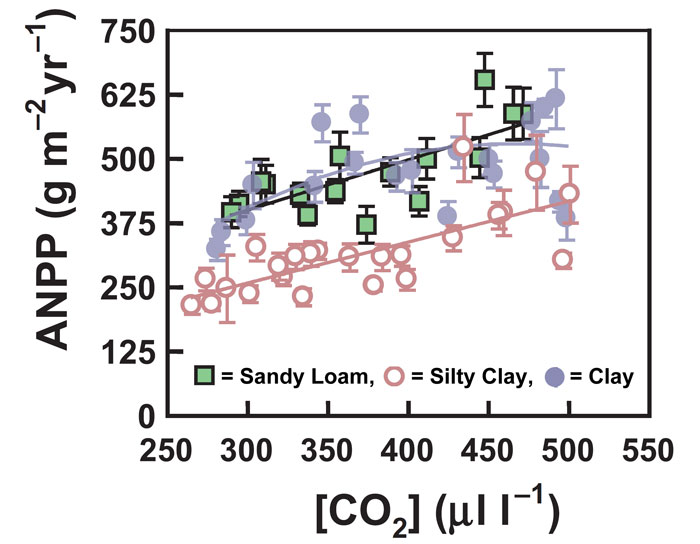| Tweet | Follow @co2science |
Paper Reviewed
Polley, H.W., Aspinwall, M.J., Collins, H.P., Gibson, A.E., Gill, R.A., Jackson, R.B., Jin, V.L., Khasanova, A.R., Reichmann, L.G. and Fay, P.A. 2019. CO2 enrichment and soil type additively regulate grassland productivity. New Phytologist 222: 183-192.
Grasslands cover approximately one-quarter of the planet's land surface and are an important component of the global carbon balance. Consequently, there is considerable interest in how these ecosystems might respond to changes in atmospheric CO2 and climate (see, for example, the many reviews posted on this topic under the heading of Grasslands in our Subject Index).
The latest study to explore this topic comes from Polley et al. (2019). Working at the Lysimeter CO2 Gradient facility in central Texas, the team of ten researchers conducted a ten-year field experiment to determine the effects of soil type and atmospheric CO2 concentration on the aboveground net primary productivity (ANPP) of native Texas grasslands. Native grass assemblages were grown inside of transparent, tunnel-shaped chambers enclosed in a transparent polyethylene film that included a CO2 gradient from 250 ppm to 500 ppm, with the CO2 only being maintained during the growing season of each year. Three soil treatment types were also included in the experimental design: clay, sandy loam and silty clay.
In discussing their findings, Polley et al. report that increasing the CO2 content of the air from 280 to 480 ppm resulting in an ANPP increase of approximately 170 g m-2 that was realized across all three soil types. Alternatively expressed, elevated CO2 increased ANPP by around 49%, 84% and 38% in the sandy loam, silty clay and clay soil type treatments, respectively (see Figure 1). For comparison, Polley et al. write that the observed 170 g m-2 enhancement is similar to that resulting from a 290-mm increase in mean annual precipitation across grasslands in the Central Plains of North America.
Commenting on the CO2-induced increase in ANPP, the researchers say that "the predominant direct effect of CO2 on ANPP is probably explained by increased photosynthetic water use efficiency (assimilation rate/transpiration rate)," which increase "probably arose from increased canopy-level C assimilation rates" observed in previous observations during the ten-year experiment. And that is wonderful news for these important ecosystems and the animals and humans that will benefit from such productivity increases in the years and decades ahead!

Figure 1. Aboveground net primary productivity (ANPP) of native Texas grasslands growing on three different soils (sandy loam, silty clay or clay) after one year of CO2 enrichment at various concentrations above a baseline 250 ppm. Source: adapted from Polley et al. (2019).




